These books haven't necessarily been uploaded to antiqbook yet. So, if you order through antiqbook and get a message claiming the book has been sold, email in case that isn't true.

These books haven't necessarily been uploaded to antiqbook yet. So, if you order through antiqbook and get a message claiming the book has been sold, email in case that isn't true.

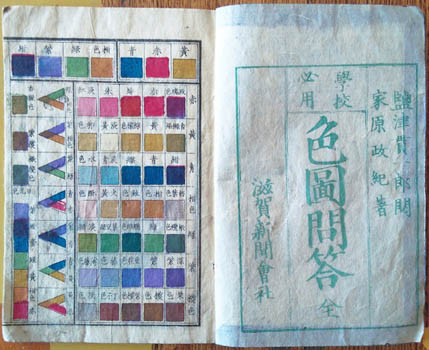
Iehara Masanori & Shiozu Kanichiro. 学校必用 - 色図問答 [Gakko Hitsuyo - Irozu Mondo]. Kyoto, Wakabayashi Kisuke 1876 (Meiji 9). 21x15cm publisher's wrapper with title label; [2],40,[2]pp on 22 double folded leaves, two colour charts and small colour squares through the text, hand coloured. Owner's inscription on the back wrapper; used but rather good copy. Damn good for an old school book. Au$600
Western colour theory introduced to Japanese students. This was, according to one historian and repeated by others, first published in 1873 but I can't find any copy earlier than 1876. I have read that it is a copy of an American book by Marcius Willson but I think there is some confusion. Willson produced wall charts for American schools that were used in Japan and I suspect that in 1873 wall chart no. XIV was introduced. His accompanying writings on color in his 'Manual of Information and Suggestions for Object Lessons' - the work cited - are nothing like this. In any case he seems to have borrowed Field's chromatics. So it was English colour theory that made its way into Japan first.
I'd make a pretty confident bet that this is the first edition.
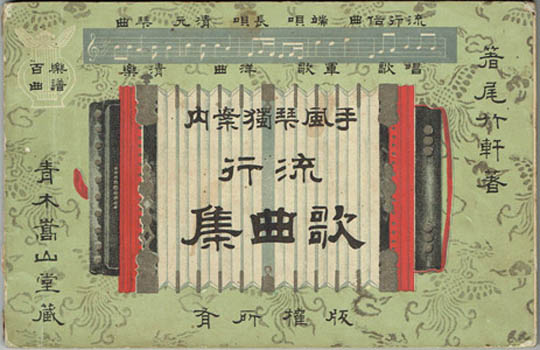
Ueda Chikuo. 手風琴獨案内流行歌曲集 [Tefukin Hitoriannai Ryuko Kakyokushu]. Tokyo or Osaka? 1897 (Meiji 30). 14x22cm publisher's colour illustrated wrappers; 70pp. Certainly used but an acceptable copy. Au$50
Third or fourth edition I think, all dated the same year. The innocent children of Japan are introduced to the accordian, harmonica, flute and blow accordian. A lot of songs notated with numbers.
The book opens right to left which may be modern enough but the title reads right to left on the cover and left to right on the title page. Song titles seem to read right to left but I got confused long before I got to the music.
There was an almost identically titled book from the same stable a couple of years earlier. What the difference is I can't say. I found no copies of either outside Japan.
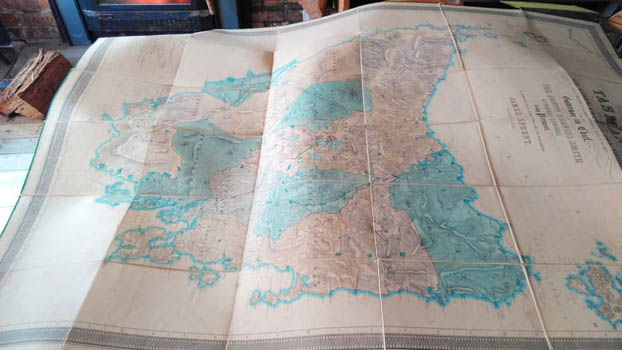
SPRENT, James & William Hogan. This Map of Tasmania in 1859, ... is dedicated to his excellency and the parliament by James Sprent, Surveyor General. Hobart Town, Walch &c, 1859. Engraved map, coloured, diced and mounted on linen, 170x120cm folding into original gilt titled morocco binding 29.5x22.5cm (rubbed and spine torn at the top). Small holes in the margins showing this map was at some time hung on a wall. Routes marked in ink. Pretty good for a map meant to be either hung on the wall or laid out on the floor and crawled over. Au$11,000
The grande-deluxe edition of Tasmanian maps and the first accurate survey. Is there a bigger c19th map of the place? Another version with the same title is less than half the size of this. A recent Surveyor General, Peter Murphy, wrote of Sprent and this map with near religious awe (James Sprent and the Trigonometrical Survey of Tasmania; 2010). It is an astounding achievement in the face of physical and technical challenges. Even more astonishing is that it survived both government and bureaucracy.
Some adventurer has marked in ink a couple of apparent journeys, one merely between Hobart and Launceston, a short trip from Deloraine to the top of The Great Lake and a more serious trip from Brighton up through the centre to the western shores of The Great Lake and then winding west, skirting the north end of Lake St Clair, to Queenstown. This is a route you couldn't follow now without a boat or wetsuit.
I think this is also a deluxe issue of this map. The Walch morocco case with gilt patterned lining paper, gilt dentelles and so on, was not standard.
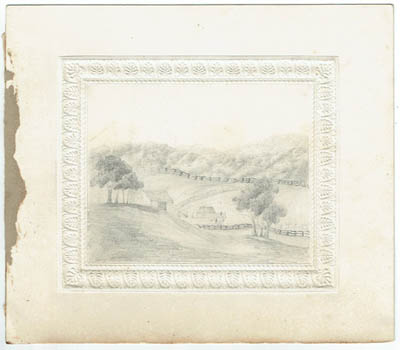
Hutton Park, Tasmania. Bisdee family. Pencil drawing of Hutton Park, Melton Mowbray, Tasmania, 1840. n.p. 111x139mm on card album leaf within embossed border, 210x245mm. Remnants of hinge along the left edge. Pencilled on the back is: "Farm yard at Hutton Park taken from the house 1840 showing the barn & the first [...?] house." Au$300
John Bisdee and his family settled and built Hutton Park, near Melton Mowbray in the southern midlands, in the 1820s. I doubt that the Bisdees ever lived in that tiny (slab?) shack in the centre of this drawing. They arrived as gentry and were given the land and doubtless convicts enough to build them the stone house that survives. But someone had to live there while the property was being established. Crude pioneer life went on here, just not for our artist on the verandah sketching in a luxurious London made album.
Bisdee talked four brothers into migrating and between them they owned a large hunk of the district by 1840. Folk like the Bisdees, what might be called the better element of the colony, did their best to transplant county life into the midlands. Once they had cleared out the bothersome Aborigines and enough forest, they introduced deer and rode to hounds - the outings of the Hutton Park Beagles made regular appearances in the papers. Apart from a group of sheltering trees around the farm house the landscape is bare for some distance these days.

Advertising - Lotus Margarine. Lotus Margarine. Fine de Table. Recettes de Cuisine. Lotus [192-?]. 21x11cm publisher's colour illustrated wrapper; 32pp, b/w illustrations and decorations throughout. Cover (and inside?) by Duzolle. Au$85
A nifty little book, packed with style and cordon bleu recipes.

FIELDING, Henry. The Modern Husband. A Comedy. As it is Acted at the Theatre-Royal in Drury-Lane. London, for J.Watts 1732. Octavo later gilt calf (spine darkened). Some browning, a good, fresh copy, complete with the publisher's list at the end. Au$475
First edition. A copy that marks the heady days of the Fielding craze of the late 19th and early twentieth centuries when every good copy that could be found was banged into smart bindings by Riviere or Sangorski and flogged to millionaires. This binding isn't signed but looks Riviere.
The Modern Husband was so thoroughly modern that it took a brave company to perform it and they were hissed on the first night. That a man could sell his wife to pay his gambling debts and then sue his customer for not paying enough was no surprise to London audiences but many did not want to see it dissected on stage. Enough did though and it had a respectable run. Fielding "began to think it was a good play till the Grub-street Journal assur'd me it wa s not."

Russian ship. Putyatin. A Bunkindo woodcut of a supposedly Russian ship. Nagasaki, Bunkindo 1853? Coloured (by stencil or hand?) woodcut on brown paper, 25x37cm. Minor rumpling. Au$475
This presumably is one of Putyatin's ships that arrived in Nagasaki in August 1853 in attempt to match any treaty Perry managed to force on Japan. Like most of these hurried prints produced to capitalise on such dramatic occurrences old, sometimes ancient, woodcuts were dusted off and reworked. In this case it's clear that a Dutch ship has been rebranded Russian. Russian enough: there are still Dutch flags flying. This saved a lot of mucking about, sending an artist down to draw each ship. Few customers would ever see the actual boat.
The British Museum has a more expected Nagasaki print which I swear is from the same block, with text and a crude added vignette. That text labels it a Dutch ship - "Hollandsche Schip" even though flags have been made Russian. I'd guess the block cutter couldn't read that bit and left it alone.
I've yet to find the original - still all Dutch - print and I'm not sure it matters. It was likely adapted from another print anyway. The grandfather of this print, as far as I'm aware, is the print of the Dutch ship Shellach from 1782 and Bunkindo published 'Hollandsche Schip' prints galore drawn from that Shellach print. There is no text but Bunkindo's seal, lower left.
Bunkindo were prolific publishers of Nagasaki prints of things foreign from the late 18th century into the 1850s. I wonder whether the band on deck playing large twirling horns was an improvement introduced for Koops' arrival in 1844 when Bunkindo went to town with prints showing the visiting band's French horns.
I also wonder if the paper here as been dyed with persimmon juice, it's certainly persimmon colour. Books expected to be used a lot - like a lending library - were often dipped in persimmon juice to strengthen the edges of the paper but I've never seen another c19th print on brown paper like this. My guess is that Bunkindo were looking for ways to brighten up a well thrashed image. This is not a beautiful print. It's no triumph of Japanese craftsmanship but it is intriguing.

Hikifuda. 新村商店 ... 下諏訪木之下 ... 和洋織物商 ... [Niimura Shoten ... Shimosuwa Kinoshita ... Wayo Orimonosho ...]. n.p. [1900]. Colour woodcut 26x38cm. Minor stain, really only noticeable in the bottom margin. Au$250
This smart hikifuda - large handbill or small poster - advertises, I think, the Shimosuwa department store Niimura Shoten where they sell Japanese and western textiles.
Shimosuwa is a town in Nagano, east of Tokyo. There are Niimura department stores still in a few towns around Japan but I suspect that it is a common name; it translates more or less as 'New Town'.
This is also a tribute to modern transport and a helpful train (and ferry?) timetable for 1900 is provided.
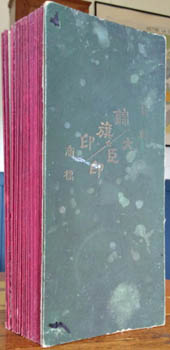
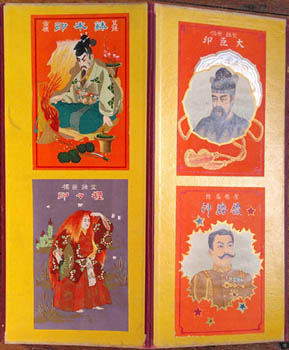
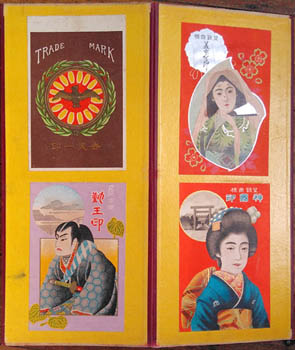
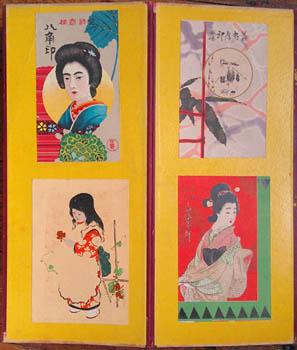
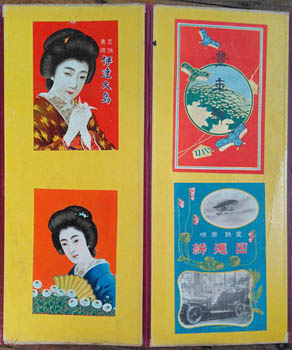
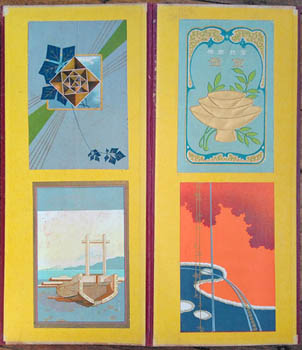
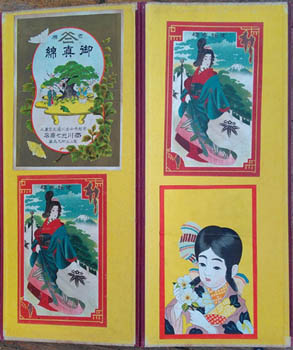
Advertising & trade marks. 登録 - 錦旗印 - 大臣印 - 商標 [Toroku - Nishiki Hatajirushi - Daijin Shirushi - Shohyo]. n.p. [191-?] 38x17cm, publisher's stamped cloth (rubbed and scraped); 79 mounted colour lithograph samples - some with embossing - on 40 heavy card mounts, accordian folding. Each label is about 17x10cm. Some rubbing and signs of use, pretty good. Au$1150
An impressive commercial album of sample trademark labels for the silk trade. Unfolded, this is close to seven metres - 22 feet - long. Lettering, where there is any, is generic, placeholders. There are variants of designs - different colours, different borders, lettered and unlettered and so on. What I can't figure out is who produced this. There are some small characters along some bottom edges and a crest here and there but they seem to repeat the words 'Toroku' and 'Shohyo' - Register and Trademark.
The silk industry wasn't given to rampant modernism at this time but there are some smart modern designs, even a motor car and early biplane in one. This would date the album to about 1910 or soon after.
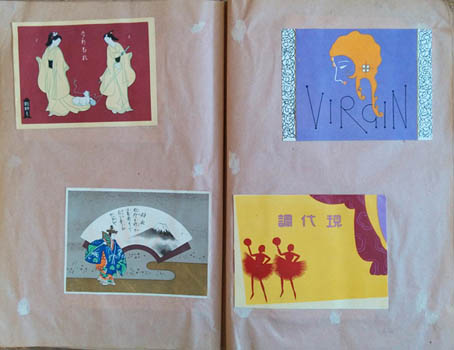
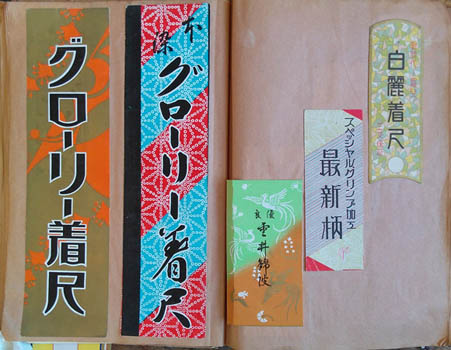
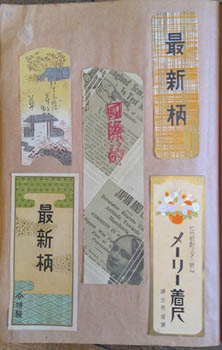
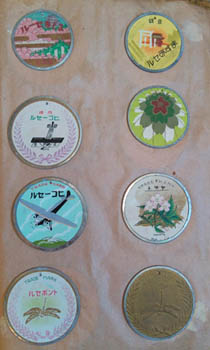
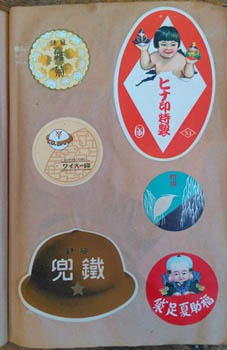

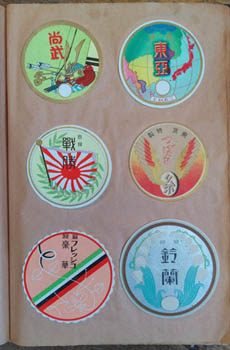
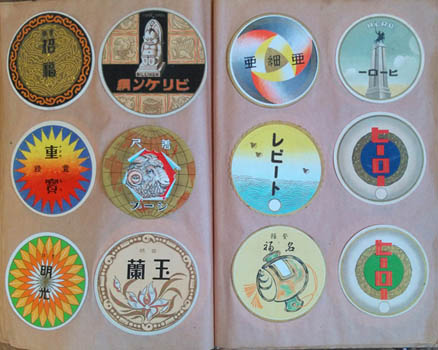
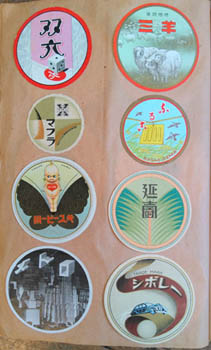
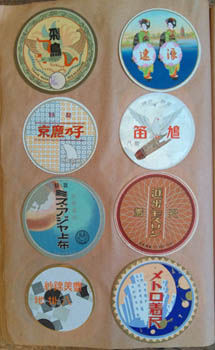
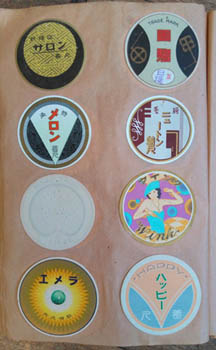
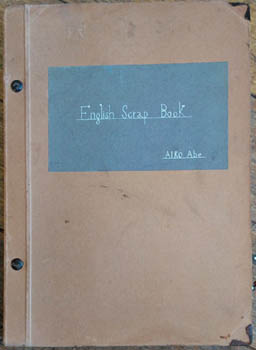
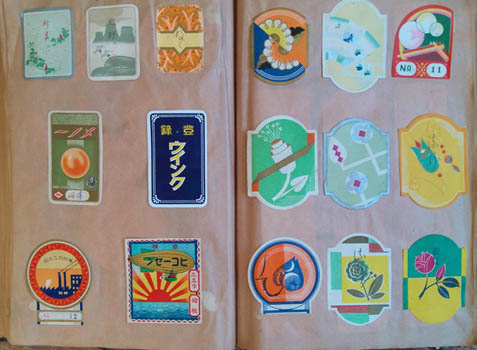
Japanese advertising. An album of specimen trademark cards and labels. n.p. 1930s. Card covered album 30x22cm labelled by hand: "English Scrap Book : Aiko Abe". Who knows why. Some 420 mounted specimen trademark cards and labels mounted on brown paper leaves. One or two labels are fabric; several circular cards have thin metal frames. Au$900
A portable gallery of Japanese commercial art of the thirties. No-one stinted in the production of these, not the artists, not the printers. Traditional, ultra moderne, fiercely nationalistic, chic, kitsch, downright baffling; it's all here.
It took me a while to puzzle out that with few exceptions these cards are commercial specimens with generic brandnames. This is not an collector's album of used labels. Producing specimen trademarks, labels, hikifuda - handbills - and posters was a damn big business. Most are beautifully printed on heavy card, one side only. And where did those metal frames come from?
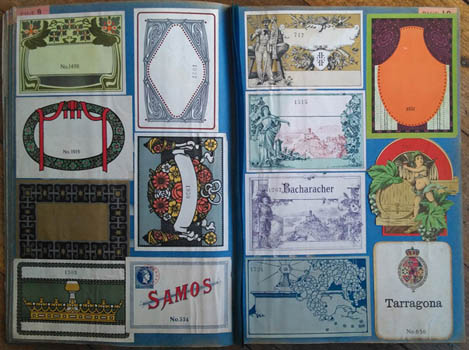
Album of specimen wine labels titled on the cover: 'Album G - Enveloppes Sachets Etiquettes-Dennison' with the initials G.M.C. under a coat of arms. n.p. [190-?]. Folio cloth backed silk paper album album, 36x25cm, titled in silver and black (covers shabby but strong); some 180 chromolitho and colour printed labels mounted on card leaves, 26 pages including the inside covers. Used and rightly so. Au$475
This album was not, or at least this copy was not, sent to customers. This is a shop working album. Specimens have been crammed in, some have been removed and others pasted over. The labels have serial numbers but no particular order, a few European languages are used and wines from France to Greece are included. Most are generic and many unlettered. There are, as well, a few labels for things like oils and soaps.
G.M.C. remains undeciphered by me. Though titled in French my guess is that G.M.C. are Belgian printers, this is aimed more at German wine makers and merchants than anyone else and that the name is some variation of Moor: Mohr, Moer, etc.
A pleasing gathering of florid fin de siecle commercial art with some smart nouveau and jugendstijl design and the never stale sumptuous gold on glazed midnight blue.

Paper Game. Het Stoomboot Spel. Arnhem, P.A. de Jong [183-?]. Woodcut broadside (49x41cm) with handcolouring. Folded, with some wear, a few small holes and stains; not a bad copy. Au$600
Racing games like this often celebrate the new, the noteworthy, the latest craze. The steamboat might have been around for a few years but it hadn't lost its gloss judging by the games that re-appeared through the 1830s.
This game, signed A.H. Binger, seems to have been printed a few times in the twenties and thirties, with the imprints of de Jong or Moolenijzer of Amsterdam. Small nicks in the block are the same in all printings but damage to one word that is both damaged and undamaged in the Amsterdam and Arnhem printings, and is replaced with letterpress here, suggests the block was shared between the two printers.
The boat pictured, the Mercurius, ran between Amsterdam and Zaandam from 1826 to 1840.

Ikeda Eisen [aka Keisei Eisen]. 新版江戸花呉服屋大雙六 [Shinpan Edo no Hana Gofukuya Sugoroku] [Tokyo], Yamashiroya Matabe [1820 - 1850?]. Woodblock print 67x46cm, printed in black, blue and pink; folded. Smudges and soiling, a couple of small chips from the top edge. A pretty decent copy. Au$1250
Another lesson, if we need it, that the Japanese had connected and mastered the important stuff of life long before the rest of us: advertising, fun and shopping. In this sugoroku - a racing game - Eisen takes us through the most prestigious dry goods stores and drapers - ie high fashion - of Edo (Tokyo) until we reach Ebisu and Daikokuten - gods, respectively, of merchants and wealth. In other words, who isn't this game for? Every working Edo inhabitant with a speck of ambition will want a place among the great merchants, rubbing shoulders with such gods while their wealthy patrons have confirmed that their shopping habits are blessed by the gods.
The titans of fashionable commerce here include Echigoya (now Mitsukoshi), Shirokiya (which lasted some three hundred years, its ghost is a department store in Honolulu), Iwaki Sotoya, Matsuzakaya (still going), Ebisuya, Daimaru (still going), Shimaya, Sawanoi and Izukura.
Eisen did more than one sugoroku: this, one of more prosaic sights of Edo, one of the Tokaido road, and an elaborate sort of fourth one - the set of courtesan prints which together form a game - are the ones I've traced. I've found two other copies of this shopping adventure, in the UC Berkeley library and in the fabulous sugoroku collection of the Edo Tokyo Museum. They are printed in yellow rather than blue.
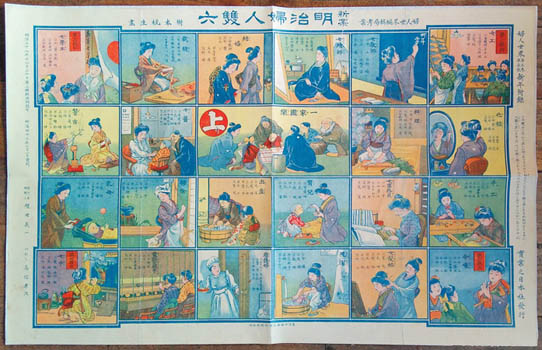
Kimoto Motoo. 新案 明治婦人双六 [Shin'an Meiji Fujin Sugoroku]. Tokyo, Fujin Sekai 1910 (Meiji 43). Colour lithograph 51x79cm. Laid down on paper sometime recently; a closed tear, few small holes, pretty good. Au$150
An aspirational record of the life of the modern Meiji woman. Women do work, as telephonists, as teachers, typesetters, maybe even as a doctor. All can be balanced with a satisfying family life. This was the new year gift from the magazine, Fujin Sekai: Woman's World.
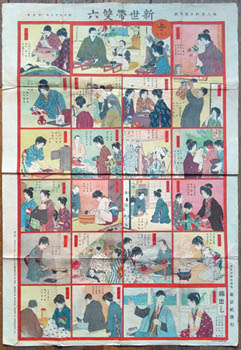
Hiresaki (or Hirezaki) Eiho. 新世帯双六 [Shin Setai Sugoroku]. Tokyo, Fujin Sekai 1918 (Taisho 7). Colour broadside 78x54cm. Folded and misfolded, rumpled and several tears repaired; a couple of holes, the largest about a fingernail in size. A ratty copy but too appealing and too rare to discard. Au$150
Reading Helen Merritt's short biography in 'Woodblock Kuchi-e Prints' there can be no doubt that Hiresaki worked himself to death. It took almost ninety years but no-one could survive his workload. For more than 20 years he drew sumo matches for Asahi Shinbun - long after other papers had turned to photos - while churning out kuchi-e for Shun'yodo, illustrations for magazines, for text books, for novels. There are also the paintings and separate prints, and this game.
This elegant New Household Sugoroku was the new year gift from the magazine Woman's World for 1918. It is gentle, quite lovely and depressing. This celebrates wife and mother, no other career in sight here. Celebrate is maybe the wrong word. These people look gentle, dutiful and melancholy about the whole business. These are not joyful folk.
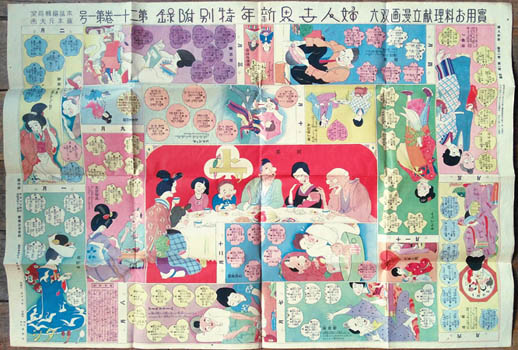
Fujimoto Katao. 実用お料理献立漫画双六 [Jitsuyo Oryori Kondate Manga Sugoroku]. Tokyo, Fujin Sekai 1926 (Taisho 15). Colour broadside 55x79cm. A little rumpled, minor signs of use and light browning; quite a good copy. Au$500
This delightful manga sugoroku celebrates cooking and was the new year gift from the magazine Woman's World.

Sugoroku. Nomura Toy Company 弥次喜多滑稽旅行双六 [Yaji Kita Rokkei Ryoko Sugoroku]. n.p. [c1930?]. Colour broadside 55x79cm; with the large original paper wrapper - 40x28cm - with mounted colour illustration. An excellent copy. Au$500
The comic adventures of those buffoons Yaji and Kita of Hizakurige - or Shank's Mare - fame, not so much updated as flung though wormholes in time. All is still Edo in period but for the airplane, those motorcars, cable car, parachutes.
This is not a sugoroku produced as a new year gift by a newspaper or magazine - the usual form of these games first half of the 20th century. It was made by Nomura Toys, presumably for sale. Hence the extra large, lurid paper wrapper. Nomura Toys started in the early twenties and went into tin toys in a big way after the war.
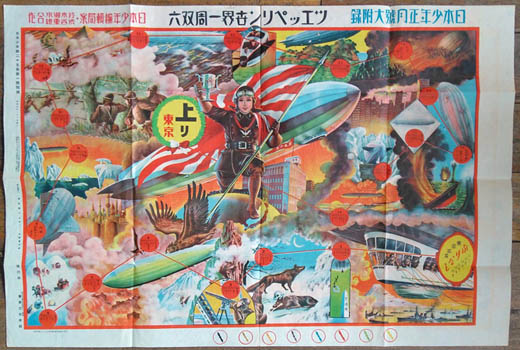
Shibuya Shigeo & Suzuki Omizu. ツエッペリン世界一周双六 [Tsuepperin Sekai Isshu Sugoroku]. Tokyo, Nihon Shonen 1930 (Showa 5). Colour broadsheet 54x79cm. Minor signs of use; a rather good copy with playing pieces - propellors - in the bottom margin. On the back is a duller game about athletics in red, white and blue. Au$550
The new year gift from the boys' magazine Nihon Shonen, this is an heroic, an epic, zeppelin journey around the world that existed in the minds of writers and illustrators for boys. Every step, every part of nature, every being, is a peril, a hazard to be fought and beaten. Girls win by accepting, boys win by taken a cudgel, or even better a machine gun, to everything in their path.
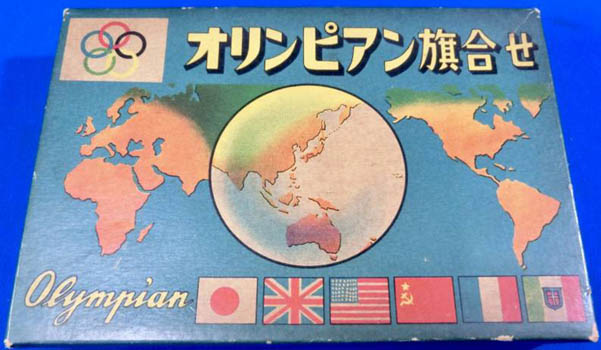
Tokyo 1940 Olympics. オリンピック旗合せ [Orinpikku Hata Awase]. n.p. [c1936-38]. Colour illustrated card box, 11x17x3cm, with 25 plastic tiles each with a mounted paper flag. Complete and good shape. Au$125
Tokyo was chosen for the 1940 Olympics, teamed with a world's fair, despite what the Japanese were doing in China and despite any interest from the Japanese government. It was all cancelled in 1938 but a few keen entrepeneurs were already at work on merchandising.
This appears to be a memory game in which flags of six countries are matched: Britain, Italy, France, USSR, USA and Japan. There is also one Red Cross flag.

Slavery. [Gilbert Francklyn?]. A Very New Pamphlet Indeed! Being the Truth addressed to the people at large. Containing some strictures on the English Jacobins ... respecting the Slave Trade. London, printed in the year 1792. Octavo, disbound; 16pp. Au$495
The very model of a modern refutation, our writer has used all the methods still used to condemn reformers; in this case the abolitionists. By the second sentence the witnesses brought forward by the abolitionists have been "committed to take their trial for perjury." Before the end of the first page the abolitionists - Wilberforce, Clarkson et al - are attached to radical fanatics and Jacobins set on destroying Britain - no small charge in 1792. By page two the secret society of "Old Jewry" - a Presbyterian meeting house - has been unearthed and we learn that the testimony offered by these radicals comes from "discarded servants, starving surgeons, sailors taken drunk from the stews, or parsons convicted of adultery."
There are several points of coincidence between this and the anti-abolitionist writings of slave trader Gilbert Francklyn - and "Mr Francklyn" gets one brief mention, for being magnificently humane - but it may be that our author simply mined Francklyn for material. Certainly Francklyn's known pamphlets were never so thoroughly anonymous as this. Whoever the author, this received a snappish note in the Monthly Magazine. The Critical Review was also hostile and extended that hostility to damn a reply to this pamphlet, 'Old Truths & Established Facts' which has been ascribed to Thomas Paine. This second work, Paine or not, was condemned for its lack of originality; our pamphlet for its "scarcely defensible" stratagem of joining the abolitionist with latterday levellers.

Catalogue - cheese boxes. Joseph Lamy Fils, Bois d'Amont, Jura. Fabrique de Boites en Bois. Specialite de Boites a Fromages. Bois d'Amont, The company [190-?]. Small octavo publisher's printed wrapper with mounted illustrations (a touch faded); [6],42pp, line illustrations throughout. A nice copy. Au$60
Wooden boxes of all shapes and sizes for quarter, half and full cheeses, from Camembert to Gruyere via Roquefort, Munster, Port-Salut ... ; followed by specialty boxes for postage, pharmaceuticals and so on. Lamy Fils may have been way over on the very edge of France but as you can see by their cover they weren't behind the times; they had telephone no.1.
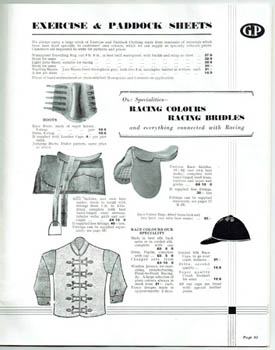
Catalogue - saddlery, harness, luggage etc. George Parker & Sons, London. Parkers Saddlery - Harness - Leather Bags - Trunks [cover title]. The company [c1930?]. Quarto publisher's printed wrapper (a bit dusty); [3].49pp, illustrated throughout. Mildy used. Au$50
Not just saddles, harness and suitcases but everything else for the horse, the stable and their owner, from attache cases to yearling sheets taking in hunting flasks on the way. I'm not surprised by the Australian buckjumping and colonial saddles but wonder how they maintained a supply of second hand colonial saddles and I'm bemused by the highly decorated cowboy saddle and fringed schappes on sale in St Martins Lane.
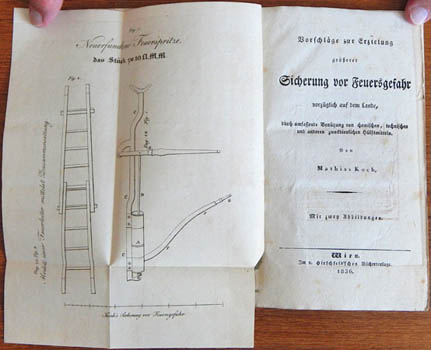
KOCH, Mathias. Vorschlage zur Erzielung grosserer Sicherung vor Feuersgefahr vorzuglich auf dem Lande durch umfassende Benutzung von chemischen, technischen und anderen zweckdienlichen Hulfsmitteln. Vienna, Hirschfeld 1836. Octavo, later but not recent cloth and boards with the title panel of the wrapper mounted; 78pp and folding frontispiece. An appealing copy with the bookplate and impressive stamp - this on the back of the title - of Franz, Count (later Prince) of Thun and Hohenstein. Au$400
Only edition of this rare critical - often very critical - review of current practice in fire protection and firefighting and proposals for improvements. Koch covers a lot in a fairly short space: building materials; protective gear; insurance. He describes and illustrates a new and cheap pump and promotes an 'artificial water' which seems to be based on lye.
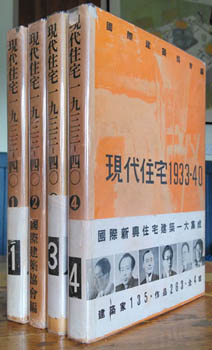
Modern housing
現代住宅 1933-40. [Gendai Jutaku 1933-40]. Tokyo, Kokusai Kenchiku Kyōkai 1941-42. Four volumes quarto publisher's cloth, dustwrappers and card slipcases (dustwrappers mildly chipped here and there, some damage or pieces from the spines of the card cases); profusely illustrated thought with photos, plans and elevations. Some browning of endpapers and edges; a remarkably good set with three of the extra wrappers showing architects featured in each volume (one of these with repaired tears but pretty much all there). Au$2,500
Second editions, each published separately as needed, and a testament to something that international modernism could still be celebrated so lavishly as war started in earnest. An encyclopedic survey of modernist housing over eight years that can stand proud enough alongside anything coming out of Switzerland, Germany or Italy. I'd say it's no accident the jackets and boxes are lettered to resemble film.
Housing has been generously defined to include apartments and hotels. These buildings are well documented inside and out, garden to furnishings. Captions in English identify the house and architect. Architects include Taniguchi Yoshiro, Tsuchiura Kameki, Sugawara Eizo, Sato Takeo, Horiguchi Sutemi, Maekawa Kunio, and emigres and visitors like Bruno Taut and Antonin Raymond.
A large section of each volume is also give over to exploring the rest of the world, from Shanghai to Los Angeles via Czechoslovakia. Worldcat finds three sets outside Japan and a search of likely architecture libraries added one more.
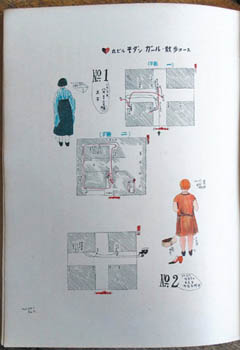
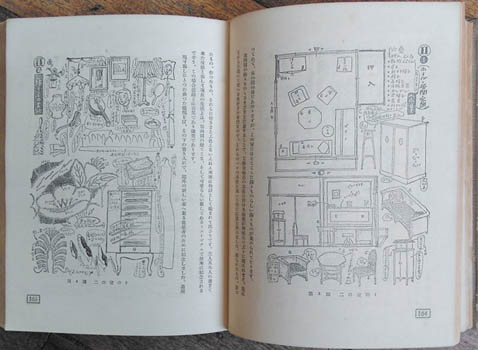
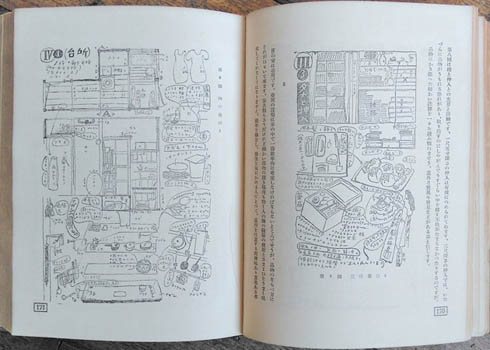
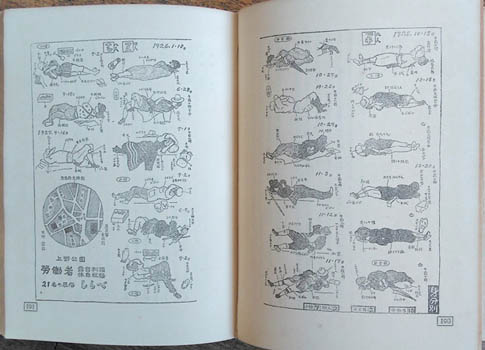
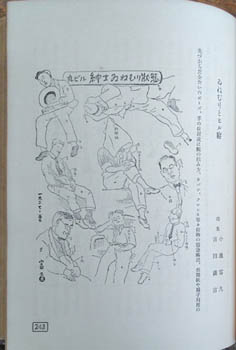
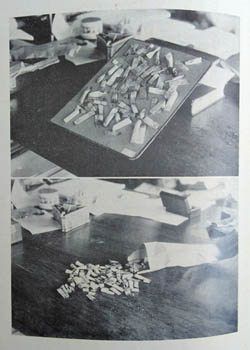
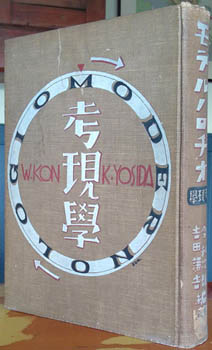
Modernology
Kon Wajiro & Yoshida Kenkichi. モデルノロヂオ - 考現学 [Moderunorojio - Kogengaku]. Tokyo, Shun'yudo 1930 (Showa 5). Large octavo publisher's decorated cloth blocked in white, red and black; 361pp, illustrations throughout, a few photo or colour plates. Used, with some minor flaws and browning; not a bad copy of a book that didn't wear well. Au$650
Second printing, printed five days after the first according to the colophon. Who would have thought? Still, this is an extraordinary book; the gospel of Modernology and hard enough to find in decent condition. Kon and Yoshida have compiled an encyclopaedia, surely unsurpassed, of the apparently ordinary, of the people of Tokyo, fit to provoke unseemly enthusiasm in theoreticians and urban planners ever since.
I gather that Kon's thesis - born out of watching the people of Tokyo begin to rebuild after the 1923 earthquake and fire - is that those who do the planning, designing and official building know nothing of what people actually do, what they own and how they use those things - how they live and who they are.

PLOYER, Otokar. Views, elevations and plans for the Remislavsky-Stome villa and studio in Prague, along with drawings and plans for a 'California Weekender'. n.p. c1930-35. Eight sheets ranging in size from single sheets 21x33cm to a four fold sheet 34x83cm. These are printed by whatever lithographic process on a heavy parchment paper and coloured by hand. All have Ployer's stamps and are signed in ink. As well there is a typed signed letter, two pages on one sheet, and a photo collage card printed on the back. Together in a contemporary portfolio, 36x28cm, with ribbon ties. Au$185
The client and the house are easy to track. Dancer, choreographer and former National Theatre Ballet Director Remislav Remislavsky and his ballerina wife Irmou Stome opened their purpose built dance school in 1934. He joined the resistance during war and was denounced as bourgeois and his villa seized in 1948 according to one biographer. He lived happily and taught on after the war according to another. The building survives and appears to be home now to a number of companies that don't actually do anything.
The architect not so much. One drawing here has a blindstamp: "Ing. Otokar Ployer Amer. Architekt" and the photo collage card with the lot is Remislavsky's announcement that the school will open in September 1934 and was purpose designed by American architect "Playerem" (sic). On other drawings he is Ing. O. Ployer.
The letter, dated January 1 1936, with the lot explains this group of drawings. He suggests in the letter that his friends might like to build his California weekender. I'd say he added a batch of drawings and plans of the Remislavsky villa - his big project - to impress his prospective clients.
He mentions he is working on the design of an air raid shelter, a useful thing to have in central Europe as the thirties progress, and he filed, from Prague, for a US patent for an air raid shelter in 1939 which was granted in 1945. Elsewhere I find the suggestion that he migrated to Sweden at some stage but in 1947 the firm Ployer Otakar of the same address in Prague advertised in a Rio de Janeiro newspaper for contacts with exporters of machinery, rubber, chemicals, coffee, etc and for importers of glass, synthetic stones and toys. 1948 may well have killed that career and seen him off to Sweden. How and where he is an American architect in all this beats me.
The drawings and the photos of the villa built show that a fair amount of rationalisation took place. A grandiose mansion of no fixed heritage is pruned to a large central European Mediterranean villa and built with not a whole lot more trimming down. His California weekender is ... maybe Spanish mission put into a car compactor.
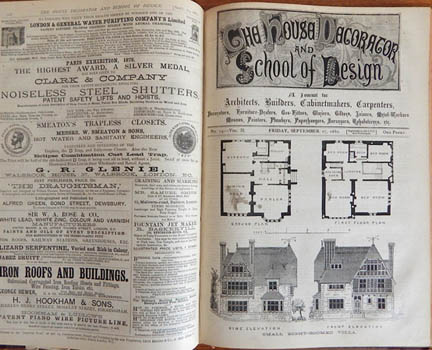
The House Decorator and School of Design ... Vol 1. [No.1 to No.26]. London, Cecil Brooks, June to December 1880. 26 issues quarto, together in contemporary half calf (front cover detached); each issue 16pp, illustrated throughout with illustrations, plans and designs; an additional double sheet of designs on coloured papers added to number one. With the added title and index issued at the completion of the volume. Au$900
A fair slab of the complete run of this uncommon trade journal it seems. I've found one record of 62 numbers (the V&A) finishing in August 1881; one of 54; one record of 29 numbers; and one indeterminate record that may or may not include numbers from 1881. Few of the expected libraries have anything.
A penny paper for the working man maybe but not old fashioned. Designs are up to date, if not startling, showing the incursion of Japonism and the aesthetic movement, and technical progress and modern concerns like sanitation are front and centre.
The title is misleading, this is for all trades - painters, plumbers and gasfitters head the list on the masthead of early issues; architects, builders and cabinetmakers take over later on. Trade news was gleaned from as far away as Chicago and Melbourne, which suggests some circulation beyond the home counties and midlands. From Melbourne came a report of a Yellow Peril meeting by furniture makers demanding that all government contracts are for "European workmen" only.
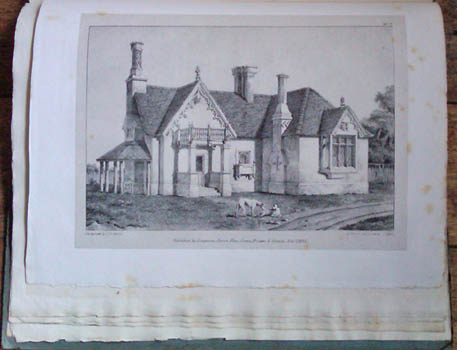
HUNT, T.F. [Thomas Frederick]. Half A Dozen Hints on Picturesque Domestic Architecture in a Series of Designs for Gate Lodges, Gamekeeper's Cottages, and other Rural Residences. London, Longman, Hurst 1825. Small folio, uncut in publisher's boards with printed label on the front (rebacked); [32]pp and 12 litho plates. Foxing but an appealing copy of the issue with proofs on India at 21/-, as opposed to 15/- for standard copies. Au$350
First edition of Hunt's first book, very much an essay in picturesque nationalism, with designs for nine buildings.
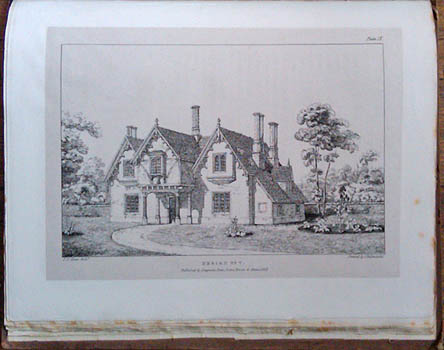
HUNT, T.F. [Thomas Frederick]. Designs for Parsonage Houses, Alms Houses, Etc with Examples of Gables, and Other Curious Remains of Old English Architecture. London, Longman, Rees, Orme 1827. Quarto, uncut in publisher's boards with printed title label on the front (rebacked); [8],34pp and 21 litho plates. Some foxing and a mild tide mark at the bottom of a couple of plates, still a pleasing enough copy. The plates, printed by Hullmandel, are on India, mounted, possibly denoting the proof issue. Au$250
The sequel to Hunt's 'Half a Dozen Hints' (1825), still firmly planted in a pure old England unconfounded by the Gothic. He makes the pointed point that his renderings are uncluttered and unsweetened by "factitious" effects. They are as built, not as they might appear with years of ivy, gardens and mellowing. We need look no further than colleague P.F. Robinson for such abject fiddling.
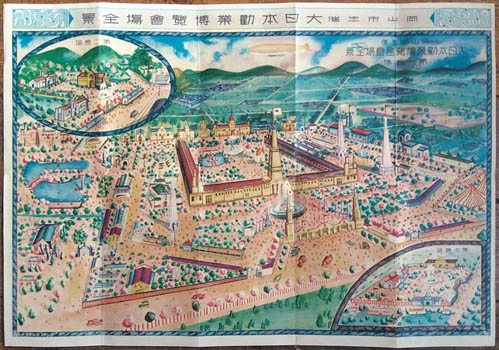
Exhibition - Okayama 1928. 岡山市主催大日本勧業博覧会場全景 [Okayama-shi Shusai Dai Nihon Kangyo Hakurankai-ba Zenkei]. Okayama City 1928 (Showa 3). Colour broadside 36x53cm on heavy paper, folding to 18x11cm brochure. Au$100
A cheerful birds-eye view of the 1928 industrial exhibition held in Okayama and a birds-eye view of the city on the other side. Hatsusaburo it's not but it's not bad. In case you are wondering, Okayama has not been moved to a small island. Rather it has been given due prominence. That island is all Honshu. Tokyo is that blot just beyond Fuji.
The main exhibition area was on the edge of the city with two smaller satellite areas on opposite sides of town. At first I was surprised by the lack of airplanes swarming the sky but there is a reassuring zeppelin. No celebration of Japanese modernity and progress was complete without something soaring overhead.
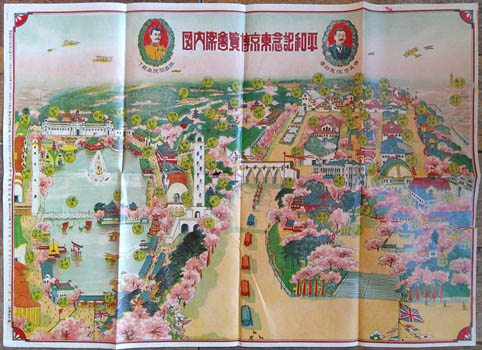
Exhibition - Tokyo 1922. 平和記念東京博覧会案内図 [Heiwa Kinen Tokyo Hakurankai Annaizu]. Tokyo, Okada Gentaro 1922 [Taisho 11]. Colour lithograph 39x55cm. Folded. A short marginal tear; some light furring caused by stacking sheets too soon after printing. This can be easily removed if you can be bothered. Au$150
The 1922 Peace Memorial Exhibition, celebrating the League of Nations and a bright future, was the most lavish national Expo ever held. The pavilions were a mix of stately, ultra modern and funfair fairy tale and the seaplane was one of the hits of the exhibition. From the number of Union Jacks waving about I'd guess that procession heading up the avenue held notable British guests.
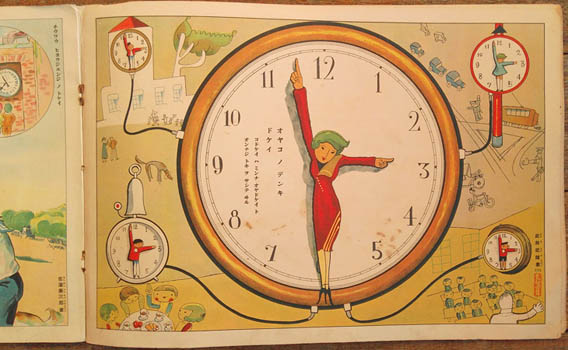
Takeo Takei & others 観察絵本 - キンダーブック [卜ケイ] [Kansatsu ehon - Kinda bukku - boku kei]. Tokyo, Fureberukan 1932 (Showa 7). Oblong folio, 26x38cm; 16pp including covers, all colour lithographs on light card. Used and a bit knocked about but a most acceptable copy. Au$200
Telling the time for kids, one in a series of "observation" books begun in 1927 by the now named Froebel-kan - based on the principles of educator Friedrich Froebel. I've found images of a few of these early books and this is the most stylish by miles. The Fureberukan has published magazines and squillions of worthy books since then, still does, and they look pretty revolting.
This one steps into nauseating cuteness here and there but the good plates more than make up for it. A number of artists contributed and in the early thirties the best were still doing imaginative work for kids' books and magazines. I can't find a record of this anywhere outside Japan.

[JACSON or JACKSON, Maria Elizabeth]. The Florist's Manual, or, hints for the construction of a gay flower garden. With observations on the best methods of preventing the depredations of insects. London, for Henry Colburn 1816. Octavo, uncut in publisher's boards with title label on the spine; 74,[2 publisher's list]pp, two folding plans for flower gardens. Rear endpaper removed, still a nice copy. Au$165
First edition of Miss Jacson's most successful book; it ran to at least three editions. According to a great-nephew Maria and her sister Frances took up their pens to bail out their feckless cleric brother, Shallcross; Maria with botany and Frances with novels. It took twenty years or more for Shallcross to drink himself to death so they each wrote four or five books between the mid 1790s and the early 1820s. The booklist at the end announces her sister's new novel 'Rhoda'.
A mix of taste manual and practical gardening this is, according to diligent feminist historians, one of the first gardening books for women written by a woman. Miss Jacson deplores both the habit of ladies leaving the layout of their gardens to the taste of their head-gardeners and the fad for American plants "with their names painted on large headed pegs". Such things "will not produce a gay flower-garden". The consensus is that 'Jacson' is the correct spelling. Librarians of the world take note.
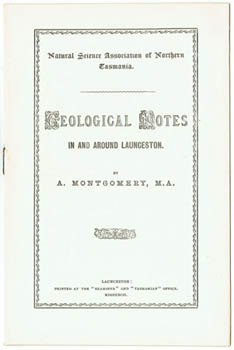
MONTGOMERY, A. Geological Notes in and Around Launceston. Launceston, printed at the Examiner &c, 1892. Octavo publisher's self wrapper; 12pp. Natural Science Association of Northern Tasmania. Au$50
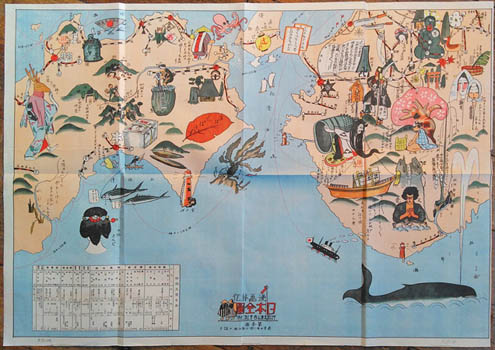
Shikoku & Wakayama. Nakamura Kisen, Inoue Seiji & Yokoyama Kei. 漫画旅行 - 日本全図 [Manga Ryoko - Nihonzenzu ... ]. [Tokyo c1930?]. Colour printed broadside map 55x77cmcm. Folded. A pretty good copy. Taisho 14 - 1925 - has been pencilled in the bottom margin. I don't know whether there's any authority for this. Au$185
A fun tourist map of the Wakayama Prefecture and most of Shikoku. Nakamura, Inoue and Yokoyama collaborated on a series of such maps of Japan, likely thirteen altogether. I don't know whether they fit together to make a giant romp round Japan.

Takaku Aigai. 靄厓画譜 [Aigai Gafu - cover title; inside: 晚成山房画譜 - Bansei Sanbo Gafu]. Tokyo, Jokichi Okawa 1880 [Meiji 13]. Two volumes 160x96mm, publisher's wrappers with title labels; double page woodcuts in black and grey. A nice pair. Au$550
First edition of this posthumous pocket painter's manual - say that three times fast - by the now celebrated late Edo Nanga painter. Nanga, or Bunjinga, the ultra refined intellectual painting based on Chinese precepts, was antithetic to print making and while some Japanese manuals were produced it was only in the Meiji that such manuals and albums of earlier masters proliferated. I can't find any record that Takaku published anything himself. But then he died quite young, in 1843, and he had no time to take on the hundreds of students his teacher, Buncho, did.
OCLC finds no copies outside the Diet Library; the British Museum has a copy but that's all I can find.

Should this be in a collection of Australian fiction?
HILLCOAT, Captain C.H. [Charles Henry]. Ida Hall or a Mystery of the Suez Canal. Glasgow, David Bryce [1896]. Narrow octavo publisher's red cloth (mild signs of use). A bit canted, pretty good. Au$300
Only edition of this uncommon thriller which sees our young Miss Ida Hall of Berkley Square [sic] snatched by slavers from a Port Said hotel. Despite the thousand pound reward posted nothing has been known of her until this account. Fear not, she will be alive and well at the end of the book despite her terrible sufferings. This wasn't Captain Hillcoat's most successful book, his Notes on Stowage went through at least three editions.
Now - at the risk of drawing too long a parochial bow - can we claim some place for this in Australian literature? Captain Hillcoat (Charles Henry Lorenzo Westernra Hillcoat in full) was of a clan of emigres. His immediate family, after time in India, emigrated to America when he was a child while at least one uncle headed for Australia. His sister Cecilia joined the Australian rush in 1866 so the place was soon packed with cousins, nieces and nephews. He certainly sailed Australian waters, as the captain of the Anglo Indian in the eighties and as captain of the Futami Maru in the late nineties. His wife died in Townsville during a voyage, in 1883, and he himself died in Gosford, NSW, in 1902.

ROSENKRANTZ, Baron Palle. The Magistrate's Own Case. London, Methuen 1908. Octavo publisher's red cloth decorated in gilt (spine a little discoloured); 32pp publisher's list for 1911 at the end - clearly not a fast seller, this book. Prize inscription for spelling on the front fly; quite a good copy. Au$165
First English edition of this thriller which, despite what the sloppy Encyclopedia of Nordic Crime Fiction says, is not a translation of Mordet i Vestermarie (1902), Denmark's first detective novel. This particular Danish crime is the murder of an English lord in Germany and the magistrate is German, most cosmopolitan.
Rosenkrantz was maybe Denmark's busiest writer in the early 20th century - he had to support a noble's lifestyle which had already seen him in trouble when he was arrested for misuse of public funds and bankrupted.

Furuya Korin. 竹づく志 [Take Zukushi]. Kyoto, Unsodo 1906 (Meiji 39). 18x25cm publisher's boards; 50 colour woodcut designs on 25 double leaves, accordian folding. Light signs of use, a rather good copy. Au$1650
Exquisite printing, with metallic inks and dustings of mica, of often exquisite designs by the foremost of neo-Rimpa designers. One of three independent portfolios of designs by Korin each devoted to one plant. This one is bamboo. The others are pines and plums.
Korin, whose name is taken from the original master, started as a gifted but unsurprising designer - prolific and workmanlike in ambition compared to Sekka. But come the twentieth century - the final years of his life; he died young in 1910 - his albums of designs (rather than art) need no apology.
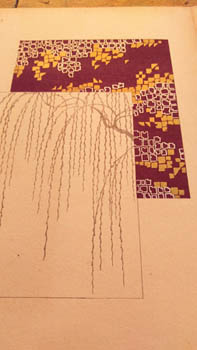
Kawarasaki (or Kawarazaki) Kodo. 花詩集 [七]. [Hana Shishu (7)]. Kyoto, Unsodo 1936 (Showa 11). 30x22cm publisher's cloth with printed label; 30 colour woodcut plates, accordian folding. A bit browned. Au$100
The last volume of this series of textile designs by prolific designer Kawarasaki. The inspiration is nature, the printing exemplary.

Tobacco. Three price and retailers lists of cigars, cigarettes and tobacco and a manual of rules and regulations from the Imperial Japanese Government Monopoly. [Tokyo?] 1908-1911. Four items, varying octavos, publisher's printed wrappers; ranging from 20 to 72 pages, errata slips. Minor signs of use, pretty good. In English and Japanese but for the regulations (1910) which is in Japanese. Au$100
A neat little precis of the tobacco market in the early 20th century, domestic and imported, at a time when decent cigarettes most likely came from Egypt, often with a gold tip. In 1904 the government nationalised all tobacco products in Japan, pushed by outrage at the multi-million dollar purchase of Japanese tobacco interests by the newly formed British-American Tobacco Company. The English sections of the lists are for foreigners in Japan.
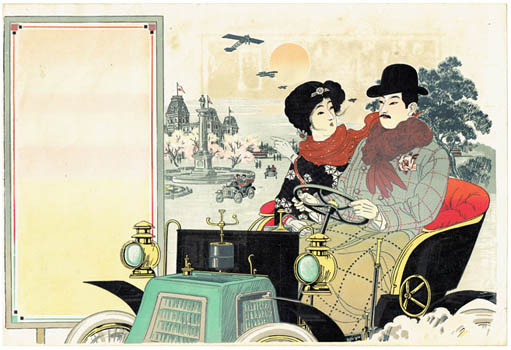
Hikifuda. Specimen hikifuda. n.p. [c1910?]. Colour lithograph broadside 26x38cm. Stab holes in right margin indicating that it was in an album. Some offsetting, an excellent copy. Au$250
A chic Taisho couple in their motor against a backdrop of beaux-arts elegance with a spattering of airplanes across the early springtime sky. These hikifuda - handbills or small advertising posters - were often produced with blank frames for customers to have their own wares and business details printed over. I'd guess this was aimed at the fashion industry. This handsome, rosy couple want no motoring coats to hide his coat, boa and buttonhole, nor her kimono. And no cap, goggles or paraphenalia to obscure her diadem.
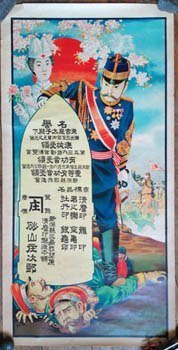
Russo-Japanese War. 名譽 - 砂山庄次郎 ... [Meiyo - Sunayama Shojiro ... ]. [c1905]. Colour lithograph 77x39cm. Some light browning, a couple of insignificant marginal tears. Au$500
A splendid poster advertising ... I'm not sure what apart from the crown prince and princess and their pluck. That is Tsar Nicholas under there by the way. There are great slogans and company names galore but I can't work out if they are actual businesses or generic examples, ie - this is a specimen poster produced for companies to consider using. In which case it is a poster advertising advertising.

EVANS, Bob [ed]. Surfing World Vol 1 No 1 ... Vol 2 No 6. Sydney, September 1962 to August 1963. 12 issues quarto together in contemporary cloth titled in gilt, all covers preserved; thoroughly illustrated. A couple of old tape repairs; rather good. Au$625
The first year of the pioneering surf journal, begun as a sport went viral and became life but still more wholesome than not - a subculture rather than the drug raddled counterculture it would soon be. Trove finds no complete run, only two libraries hold issues from the earliest years.
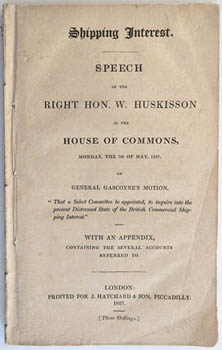
HUSKISSON, W. [William]. Shipping Interest. Speech of the Right Hon. W. Huskisson in the House of Commons ... London, Hatchards 1827. Octavo, sewn as issued; 93pp. Au$150
"Perusal of this pamphlet must infallibly produce upon the brain of any but a madman ... the overthrow [of] ... the very ignorant, or very little scrupulous, complaints brought against him ... The Speech ought, indeed, to be made the manual of everybody ... who desires a sample of the danger which might befall this country, were implicit credit given by Parliament to the assertions of interested men." (The Times as quoted in The Speeches of the Right Honourable William Huskisson).
Huskisson is of course best known now to be the first person known to be run over by a train - Stevenson's Rocket no less. Here he answers the attacks and petitions from digruntled parties all over the place against his legislation relaxing shipping laws and moving toward free trade. This was important stuff as Britain moved from being ruler of the sea to being the largest stakeholder in a web of trading nations and empires. Huskisson's record on slavery and a minimum wage for the working poor is best left unexamined right now.
Huskisson wasn't on his feet talking the whole 93 pages. A fair slab is appendices with facts and figures.
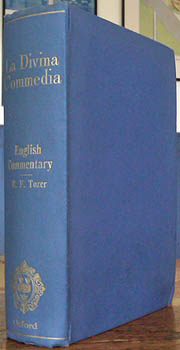
Dante. TOZER, Rev H.F. An English Commentary on Dante's Divina Commedia. Oxford Univ Press 1901. Octavo, rather good in publisher's cloth; viii,628pp. Au$80

HOYLAND, John. A Historical Survey of the Customs, Habits, & Present State of the Gypsies; designed to develope the origin of this singular people, and to promote the amelioration of their condition. York, printed for the author by Wm. Alexander 1816. Octavo 19th century half gilt calf (a little rubbed); 266,[2 publisher's list]pp. Some light browning, most obvious on the title page, but a rather good, quite handsome copy. Au$275
First edition; only edition really, leaving out modern reprints and facsimiles. Notable for being the first serious book on, and the first sympathetic defence, however misguided, of the English Gypsies. And notable for the insubstantial stories about Hoyland himself, his supposed fall from Quaker grace and dalliance with Gypsy maidens.

LOUGHEED, Victor. Vehicles of the Air. A popular exposition with working drawings. Chicago, Reilly and Britton 1909. Solid octavo publisher's cloth; 479pp and some 269 photo illustrations and diagrams etc through the text. Quite a good copy. Au$150
First edition and right up to date; published in November 1909 it covers the Paris Aeronautical Salon which closed in mid October. I hope whoever organised the illustrations for this book was never allowed near the blueprint of a machine; I trust it wasn't Lougheed, who designed motors. Nor his brothers who became Lockheed Aircraft Company.
Lougheed anticipates a future with small machines for one or two persons, cheaper than a motorcycle; more or less an evolutionary step from the motor car in terms of individual freedom.

Wine Labels - Sample Book. Myncke Freres, Brussels. The printer's sample album of wine labels printed by Myncke Freres of Brussels. n.p. 1930s. Oblong quarto (230x315mm) flexible linen album with some 220 lithograph labels plus some neck labels and vintage dates (ranging from 1915 to 1937) mounted on both sides of 31 leaves. Nothing removed and all in great shape. Au$550
This is an album to be shown to clients rather than a scrap book. There are numbers of labels for specific wineries and appellations and numbers more that are for generic varieties or, in some case, unlettered altogether. All are signed Litho Myncke or initialled LM or MF.
The Mynckes seem to have made something of a specialty of wine - a rummage round the internet finds a couple of large posters for champagne - and this album shows they had a fairly long reach across western Europe - France, Belgium, into Germany and includes some Port labels in English. The styles also range around, from the classic and restrained (it's hard to beat a modicum of gold on glazed midnight blue) to vibrantly modern to garish kitsch.

Hikifuda. Tsumura Juntendo. 中將湯 - へルプ [Chujo Yu - Herupu]. [Tokyo? 1908-09]. Colour lithograph 265x375mm. Old vertical folds, stabholes in the right margin and tips clipped from the left corners indicating it was once part of an album. A pretty good copy. Au$225
Tsumura Juntendo - still in business - began selling herbal remedies in Tokyo in the 1890s and HELP - Tsumura's herbal wonder cure for women - went on the market in 1907. This handsome hikifuda - handbill or poster - includes a calendar for 1909.

New Guinea. Keystone View Company. Stereoscope card: Natives of New Guinea in their picturesque sailing craft. Keystone [190-?]. Stereo images on printed card (89x178mm); printed description on the back. The card curved, in fine condition. Au$30
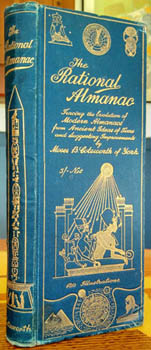
COTSWORTH, Moses B. The Rational Almanac Tracing the Evolution of Modern Almanacs from Ancient Ideas of Time, and Suggesting Improvements ... 13 months to the year. Holidays and festivals, also weekdays fixed on permanent days ... 180 illustrations explaining the mystery of the pyramids, sphinx, obelisks, druidical circles, mounds, vertical stones, etc. Acomb, York, Cotsworth [1904?]. Very tall, narrow octavo publisher's elaborately decorated gilt cloth (a bit rubbed and bumped or worn at tips); [6],16,64,16,1-154,154a-154p,155-471pp, numerous illustrations throughout. Used but still quite a good copy. Au$275
Just the form and appearance of this book invites ridicule and relegation to the loony fringe. And so it seems to have been for the most part. Cotsworth was well respected and successful in statistics and accountancy but, according to George Eastman, he was broke in New York by 1924 having spent everything and sold his collection of pictures to finance his International Fixed Calendar League. Eastman stepped in, backed him for a number of years, and applied his calendar within Kodak.
In the mid to late twenties it seemed possible - the League of Nations had taken on his calendar and the US government was taking it seriously. Most of this almanac is devoted to investigating and explaining ancient measures of time. I've come across many citations of the importance and lasting worth of Cotsworth's work here but most of them come from doubtful sources; they may be true, or not.
A note by Cotsworth explains that this book was printed over a number of years; some of the pyramid stuff before his 1900 trip to Egypt which "led to those remarkable extensions which proved to be so highly desirable, although they deferred the issue of the book and considerably increased the cost"; the earlier part of the almanac section in 1902; the "main proposals were in print before March, 1899"; and a 16 page section on pink paper is priced at a penny and was issued separately.
It is designed to fit a pocket, a deep one, and this copy shows signs of being pulled in and out of a pocket more than thumbed.

CALABRELLA, Baroness de. Evenings at Haddon Hall ... with illustrations from designs by George Cattermole. London, Colburn 1846. Largish octavo later half blue crushed morocco by Root; 24 handcoloured plates. An excellent, handsome, quite remarkable copy. Au$375
First edition. Haddon Hall hasn't been admitted into the Gothic canon and this is almost unfair. A melange of tales - one by Ainsworth - most have more than enough blood, murder, turmoil, torment, torture and revenge to qualify.
This was immensely popular through the 19th century, perhaps due to Cattermole, but I think it now has been wrongly relegated with the simpering Victorian books down the pretty end of the shelf. I couldn't find a publisher's advertisement for coloured copies so it presumably wasn't offered for sale coloured; I did find a record of a copy, also bound by Root, with the plates in two states - what these states were wasn't explained.

ROBERTS, Morley. The Adventure of the Broad Arrow. An Australian romance. London, Hutchinson 1897. Octavo publisher's cloth (cover marked); eight plates by A.D. McCormick. A few spots and minor signs of use; a pretty good copy. Au$450
First edition, colonial issue, of one of the more famous west Australian lost race novels - though lost race is stretching it a bit. The white tribe here is descended from escaped convicts. But they are swimming in gold and there were pygmy cave dwellers.
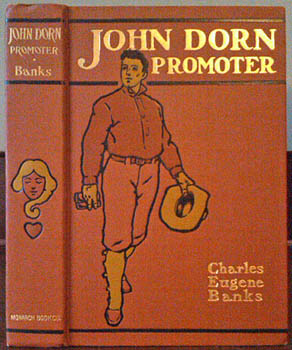
BANKS, Charles Eugene. John Dorn Promoter. Chicago, Monarch Book Co 1906. Octavo, excellent in publisher's illustrated cloth blocked in ochre, black and gilt; illustrations by August Abelmann. A sparkling copy. Au$100
First edition of this thrilling romance of the timber industry featuring a swindling count, an heroic Indian chief and a rabbi. Is it the start of a bad joke?

SUE, Eugene. Paula Monti: or, The Hotel Lambert. London, Chapman and Hall 1845. Octavo 19th century gilt half calf (side a little scuffed); 20 plates "engraved under the superintendence of Mr. Charles Heath, from designs by Jules David". An excellent and handsome copy, mostly still unopened. Au$175
First English edition of this romantic thriller. From near the end: " ... deceived by the dusk, by Bertha's cloak, and particularly by his conviction that his wife was in the chalet, shot the princess. The next morning the shawl of Iris was found floating in one of the lakes. It may be remembered that De Morville had said to Paula that a solemn oath ... another of the machinations of Iris ... the gipsy girl had ... represented a fearful picture of the fierce and suspicious jealousy of the Prince ... some murderous strategem ... " And I've still left you plenty of thrills.
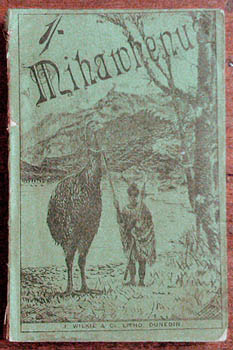
BROCK, R.W. [ie John Alexander Barr]. Mihawhenua: the Adventures of a Party of Tourists Amongst a Tribe of Maoris Discovered in Western Otago, New Zealand. Recorded By R. W. Brock, MA, LLB. Edited By R. H. Chapman. (Being a Manuscript Addressed to the Editor, Found Attached to a Maori Kite on Mount Alta ... Dunedin, Wilkie & Co 1888. Octavo publisher's illustrated wrapper (spine chipped); 198,[2 adverts]pp. Used but a very decent copy. Au$450
A lost race thriller with the race being discovered in a lush world around a warm lake hidden in the mountains. Barr published a few novels all in a rush, including two thrillers - one Australian - under the name Gilbert Rock but his own story is perhaps more exciting than Moa riding Maoris, cannibals, and treacherous French sailors. A Dunedin lawyer, he petitioned in 1888 for a protective tax on all imported literature, assuring the government that he was "prepared to supply the colonial market with literature if inducement offers." All his known novels then appeared by November. Soon after he did 'the Pacific Slope' (a great term I hadn't heard before), abandoning his family and absconding with many thousands of his clients' pounds either lost or in his pocket.
Here Barr vanishes from view except for a startling piece in the Auckland Star of October 1 1894 in which is mentioned a letter just received by Sir George Grey from the author of Mihawhenua with a return address but an indecipherable signature. No-one could decipher the signature so Grey's secretary cut the signature from the letter and pasted it onto the reply. No connection was made between the author of Mihawhenua and the missing lawyer. A final glimpse is a London death notice in 1907 which identifies him as a former solicitor of Dunedin and tells us he has been living in England with his wife and family for five or six years. I wonder if it was the same family.
The dedication, to the colonial press in "grateful acknowledgment", of one of his thrillers, 'By Passion Driven', was declined on conscientious grounds by the Christchurch Telegraph who said, "What object Mr Gilbert Rock could have had we do not know". Perhaps his dedication was for The Daily Telegraph who described his 'Colonists' as "not a badly told story."

VESCELIUS-SHELDON, Louise. An I.D.B. in South Africa. NY, Lovell [1888]. Octavo publisher's illustrated cloth (a couple of small spots); illustrations through the text. Minor signs of use but a good, bright copy. Au$125
First edition, there was a London issue using these sheets. I don't want to give away too much but this is complicated. We begin in a theatre box in the Kimberley diamond fields with Herr Schwatka divulging to an near stranger that the fascinating beauty in the box opposite has Zulu blood. Before the end of this short chapter Count Telfus has been arrested in that same box for having an illicit diamond (IDB is an illicit diamond buyer), handcuffed, locked up and has shot himself in his cell. The South African police frisk prisoners for diamonds, not guns.
Donald Laure worships his part Zulu wife Dainty but has a guilty secret or two. She has not yet had the passion in her soul awakened but she does have a black dwarf servant with a glass eye.
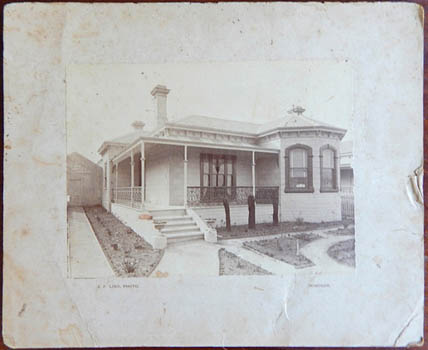
James P. Lind. A pair of photographs of a Melbourne house and garden taken when new and sometime later. n.p. [188-?] Two albumen prints on photographer's printed mounts; the mounts 248x304mm, the images 155x209mm and 150x211mm. The mounts damaged and stained, the second photograph with some spotting; a small blotch on the first. Au$800
Unusual: a pair of professional house portraits taken from the same spot a few years apart. In the first the comfortable bungalow is brand new and the bare garden is laid out and optimistically stars three tree ferns. In the second the garden is established but for the poor tree ferns and the owners are proud to be on display showing off house, garden and industrious maid. A curious feature of this house is what must be a mock stone exterior, should make it easy to identify if it still exists.
Lind's address on the later photo here is 91 Chapel Street, Windsor. Davies and Stanbury place him at 915 Chapel Street, Prahran, in 1891 but I think that's a transcription error.

POPE, James H. Health for the Maori: a manual for use in native schools. [with] Te Ora Mo te Maori: he pukapuka mo nga kura Maori. Wellington, Govt Printer 1884. Small octavo, the two together in contemporary gilt calf (edges scuffed); 121pp;129pp. A rather good, appealing copy. Au$450
Both the English and Maori versions of this plain speaking work. After all, "Maoris, old and young, call a spade a spade" and they need to hear the truths "which they must learn to respect if they are to escape extermination". One chapter is titled "Why the Maori Population is Decreasing, Although War has Ceased" in which due respect is given to the problems introduced by whites - pakeha. But Pope is adamnant that it is the fault of the Maori that they choose to accept the bad customs of the pakeha - rum among them - and not the good customs like tilling neat patches of fenced ground. The Tasmanian Aborigine, with some magnificently specious reasoning, is made an object lesson: that now extinct race "learned some of the bad ways of the whites, but none of the good ones."

Charles Bayliss. Photograph of Pitt Street, Sydney, looking south. n.p. [c1881-83]. Albumen print 150x199mm, on original mount now trimmed close, with studio blindstamp, in excellent shape. Au$450
Bayliss manages here - in this woman-free view of mercantile Pitt Street that shows a more established, grander street than some of his other views of Pitt Street - to capture all the elements of a lesson in perspective from a baroque drawing master.

Charles Bayliss. Photograph of George Street, Sydney, looking south. n.p. [c1884?]. Albumen print 149x202mm, on original mount now trimmed close, with studio blindstamp, in excellent shape. Au$450
A fine busy view of the retail heart of Sydney. More ramshackle than the financial monoliths of Pitt Street, none of what can be seen here survives. In the centre of the picture is the Royal Hotel. To its left is Foley's Hotel.

Exhibition - Paris 1867. RIMMEL, Eugene. Recollections of the Paris Exhibition of 1867. Philadelphia, Lippincott [1868]. Octavo publisher's green cloth decorated in gilt; 340,[4],xvi [adverts]pp, wood engraved illustrations throughout. Light foxing; a rather good, bright copy. Au$300
American issue but London printed, London bound and with London advertisements. It came out with London, Paris and Philadelphia imprints in English and is a translation from the French edition, based on articles for two newspapers. A good general survey by the perfumer, both artistic and scientific, including a modest illustration of his own perfumery stand and an account of his exhibited apparatus. Some but not all of the advertisements at the end are for his perfumery and his 'The Book of Perfumes'.

BROOKS, Detective James J. Whiskey Drips. A series of interesting sketches illustrating the operations of the whiskey thieves in their evasion of the law ... to which is added, a circumstantial account of his attempted murder by the Philadelphia Whiskey Ring ... the only authenticated instance of hired assassins in the United States. Philadelphia, Evans [1873]. Octavo publisher's decorated brown cloth blocked in gilt and black (spine tips worn); 349,[3]pp and four wood engraved plates. Inner front hinge cracked but firm. Au$120
First edition, it was reprinted or re-issued in 1876 with the duller title The Adventures of a United States Detective. Quite uncommon, unlikely as it seems for this type of American book of this period. Usually there are plenty of shabby copies of such books around.
Unlike many of these true stories Detective Brooks did exist, he was famous for his Whiskey Ring exploits. He became head of the American Secret Service and died in 1895 of heart trouble - apparently exacerbated by having a bullet imbedded in it for 16 years.
Whether or not he wrote this it is pacy and readable and as much of his investigations involved corruption within the service as illicit distilling.

Gall etc. COMBE, George and Dr. A, [Andrew]. On the Functions of the Cerebellum, by Drs Gall, Vimont, and Broussais, translated ... by George Combe; Also Answers to the Objections Urged Against Phrenology by Drs Roget, Rudolphi, Prichard, and Tiedemann, by George Combe and Dr. A. Combe. Edinburgh, MacLachlan & Stewart 1838. Octavo publisher's patterned cloth with paper spine label (a bit marked); xliv,339pp, a few illustrations. A mild tidemark on the endpapers but no further in.
An appealing copy even without the inscription 'To Dr. A. Brigham with best regards from Geo.Combe 12 November 1838'. Au$850
First edition and a pretty fabulous association. Amariah Brigham was a founder of American psychiatry and, like many well-meaning reformers and progressives in the field, held to phrenological principles. Combe was in America in November 1838, it was early in his American lecture tour - a stay of two years - and had met Brigham on his arrival in New York. Brigham was more or less in charge of arranging the lecture tour.
The date of this inscription is puzzling: Combe's entry for November 12 in Notes on the United States of America (1841) recounts a visit to Salem but nothing more. So why this day? The book itself is one of the central pillars of Combe's, all the early phrenologists, attempt to establish a sound scientific and reasoned basis for phrenology in the face of ridicule and attacks of more respectable and respected scientists.

MOORE-BENTLEY, Mrs M.A. An Original Hypothesis of the Origin of Life. n.p. [Sydney 1917? - some copies are inscribed "Copyright by the Author 1917" ]. Octavo publisher's cloth, titled in gilt on the front cover. [4],202pp including 45 illustrations on 10 leaves numbered 192-201, 202 on verso. Printed from typescript with some ms corrections. Ex theological library - as was the last copy I found - but not offensively so. Au$175
Mary Anne Moore-Bentley is perhaps best known as the author of A Woman of Mars, or Australia's Enfranchised Woman (Sydney 1901) which involved a visiting Martian feminist. The complexity of this work precludes me from offering a synopsis; it ranges from the supposition that 'organic life originated from photographic impression' to an investigation of the 'affect of faith upon skin pigment'.
An unjustly neglected work? I don't know, but neglected certainly. Mary Ann Moore Bentley, or Mary Ling (her married name), stood for the senate in 1903 - the first year women in New South Wales could vote - and, while she didn't win a seat, she did pretty well for votes. She self published a number of pamphets and polemical books over the years; this is maybe the most ambitious and the oddest.

CLAPPERTON, George. Practical Paper-Making. A manual for paper-makers and owners and managers of paper mills ... London, Crosby Lockwood 1894. Octavo, excellent in publisher's cloth; xii,208pp and two publisher's lists, the second dated 1901, 16 illustrations on eight plates. Inscribed 'H.J. Spicer Esq from his brother Sam April 1904' - surely members of the current generation of paper makers. Au$150
First edition. Though it took a few years to sell there were more over the next thirty odd years. I think the last was revised by the next generation of Clappertons (Robert Henderson) in 1929, the same year he published his Modern Paper-Making which presumably superceded this.

CLAPPERTON, Robert Henderson & William HENDERSON. Modern Paper-Making. London, Benn 1929. Large octavo publisher's cloth; 365pp & illustrated adverts, numerous photo illustrations, diagrams, measured drawings &c (one folding). A signed presentation from Henderson to G.D. Clapperton. Au$100
First edition, a couple more followed. A solid technical account of materials, treatment and machinery written to encompass the "amazing advances in the technique of paper-making during the last decade". It remained the standard work for the next three decades.
The paper making Clapperton and Henderson dynasties remain unplumbed by me. A Clapperton and a Henderson, both sons of neighbouring papermakers, worked for Cowans in Edinburgh and died in the first world war. Is G.D. the earlier generation's George whose Practical Paper-Making was published in its last edition revised by R.H. this same year? And I doubt that it is any coincidence that Clapperton's second name is Henderson.

LIVINGSTON, Robert R. Essay on Sheep: their varieties - account of the Merinoes of Spain, France &c. Reflections on the best method of rearing them, and raising a flock in the United States; together with miscellaneous remarks on sheep and woollen manufactures. Concord N.H. Daniel Cooledge 1813. 12mo in sixes publisher's quarter calf and marbled boards; 143pp, a wood engraved Merino on the title. Some browning and signs of use but a pleasing original copy. Au$275
Third edition; first published in 1809. Livingston is remembered in America but not, outside sheep circles, for introducing the Merino to America, unlike Macarthur in Australia who has a prominent place in the history books and whose portrait, along with a merino, adorned our currency for some time.
Still, Livingston did pretty well out of them anyway even if he did have to, as has been stated, create his own boom by buying back his own stock until the rising prices caught the interest of others. And he got his own stamp - but for his political and diplomatic achievements. This is an extended advertisement for the Merino but he does pack in some practical lessons learnt first hand.
Livingston was aware of Macarthur - he introduces him as the success story of the southern hemisphere - and it seems inconceivable that this book in turn wasn't used in Australia but of the four editions (three American and one London edition with notes by William Cobbett) I can only trace the copies in the Mitchell Library (this edition) and Sydney University.
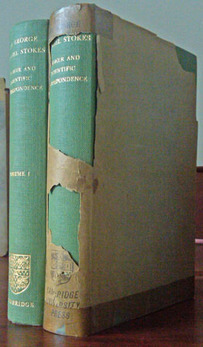
STOKES, George Gabriel. Memoir and Scientific Correspondence .. selected and arranged by Joseph Larmor. Cambridge Univ Press 1907. 2 volumes octavo, very good in publisher's cloth with remants of the dustwrappers; 475 & 507pp, four portraits. Au$500
Quite uncommon.

BROWN, Ernest W. An Introductory Treatise on the Lunar Theory. Cambridge Univ Press 1896. Large octavo, very good in publisher's cloth (a touch worn at the tips); xvi,292pp and errata slip. Au$750
First edition and quite scarce. It's a bit off the point but this extract from a letter on teaching by Professor W. Edwards Deming of New York University caught my attention: "No luster of personality can atone for teaching error instead of truth. One of the finest teachers that I ever knew could hold 300 students spellbound, teaching what is wrong. The two poorest teachers that I ever had ... were Professor Ernest Brown in mathematics at Yale and Sir Ronald Fisher at University College in London. Sir Ernest will be known for centuries for his work in lunar theory ... People came from all over the world to listen to their impossible teaching, and to learn from them, and learn they did".
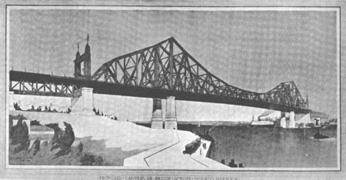
Sydney Harbour Bridge. [BRADFIELD, J.J.C.] Sydney Harbour Bridge. Report on Tenders. Sydney, Govt Printer 1924. Foolscap folio publisher's printed boards with cloth spine; [2],63pp, 22 photo plates, 22 plans (some folding). Some signs of use but a pretty good copy. Au$650
The Harbour Bridge decided upon at last. After more than 25 years of commissions, competitions, unfulfilled legislation, recalcitrance and bloody-mindedness, Bradfield announces the bridge we finally got. He does more than this of course, making this probably the most useful document in the long and turgid history of the bridge: the Report reviews all the proposals by the six firms that submitted tenders and illustrates the major contenders - thus giving us a pageantry glimpse, at least, of what Sydney Harbour might have looked like.
Despite this open-minded approach there is little doubt that Bradfield had already designed the bridge that would be built - the first tender specifications issued were withdrawn and the revised specifications pretty well spelled out the bridge that Bradfield was prepared to build (based on New York's Hell Gate Bridge).
The final sections detail the stages of construction and we end with a glowing vision of the bridge illuminated for an occasion of 'national rejoicing' - exactly what we have each New Year, except that Bradfield's bridge is illuminated as a memorial to the military forces.
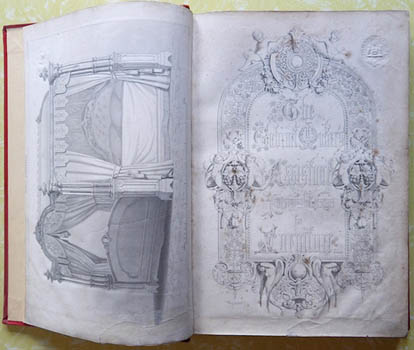
Peter Thomson. The Cabinet Makers' Assistant: a series of original designs for modern furniture ... Glasgow, Blackie & Son 1859. Folio later quarter morocco; viii,4,lxxxx,60,63pp, 101 plates. Used and ex library with a stamp on the title and blindstamps on the plates, some repairs to edges; a decent copy of a working book. Au$900
One of three or more editions or issues between 1853 and 1863 and maybe the most used mid-Victorian furniture pattern book there is. Furniture from this book was made all over the world.
Thomson was not so prescient: he notes that Australian cedar is useful for packing cases but I bet Lenehan's 1857 cedar table for Government House in Sydney - taken straight from plate 19 - would fetch a lot more than any rosewood or mahogany veneer Thomson had in mind.

LOUDON, J.C. An Encyclopaedia of Cottage, Farm, and Villa Architecture and Furniture; .. a new edition; London, Longman &c 1836. Stout octavo contemporary green gilt calf (edges a bit rubbed, a small and inoffensive flaw in the back hinge); xx,1138pp, hundreds of wood engraved illustrations and plans. Quite a handsome copy. Au$975
Probably the fourth edition, and probably much the same as the 'new edition' of 1835, both claiming numerous corrections and re-engraved plates - this refers to the original litho plates that had already disappeared from many copies of the first edition, replaced by wood engravings.
Only the first edition had the imprint of Howe in Sydney and Melville in Hobart but nonetheless this book, in all its editions, was the most used architecture book in Australia during the middle of the 19th century.

Catalogue - Cast Iron. A. Durenne, Paris &c. Societe Anonyme des Etablissement Metallurgiques A. Durenne. The company c1900. Octavo publisher's cloth backed boards (rubbed and a bit worn); [2],727pp, thousands of illustrations. Used but decent enough. Au$450
An enormous range of balustrades for balconies, staircases, bridges, friezes and fringes, door panels and fanlights, balusters, columns, pilasters, finials, grilles and gates, etc. Printed earlier but issued after the 1900 Universal Exposition, with a stamp on the title announcing their prize.

[BALLANTYNE, R.M.]. Fighting the Whales; or doings and dangers on a fishing cruise. London, Nisbet 1863. Small octavo publisher's decorated green cloth blocked in gilt and blind; 124,[2]pp, four colour litho illustrations; two page publisher's advert at the end. A nice, bright copy. Ballantyne's Miscellany volume I. Au$135
First edition and an appealing copy of this dramatic little book. Nisbet advertises 15 titles in course of preparation and 16 did appear over the next several years, but not all the titles advertised.

LEGRAND, Edy. Voyages Glorieuses Decouvertes des Grands Navigateurs & Explorateurs Francais. Paris, Tolmer 1921. folio publisher's illustrated boards & cloth spine; 2 folding maps & illustrations throughout coloured by pochoir. A remarkably good copy in a cloth chemise and slipcase. Au$750
One of the triumphs of modern French book making which, fittingly enough looks back to the triumphs (or glory at least) of Cartier, de la Salle and La Perouse.
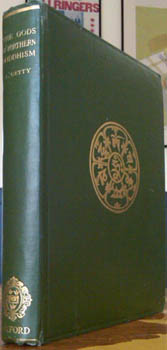
GETTY, Alice. The Gods of Northern Buddhism. Their history, iconography and progressive evolution ... Oxford Univ Press 1928. Quarto publisher's gilt cloth; lii,220pp and 68 plates (eight colour). A couple of small tape stains on the front fly, still a rather good copy. Au$300
Second edition, revised.